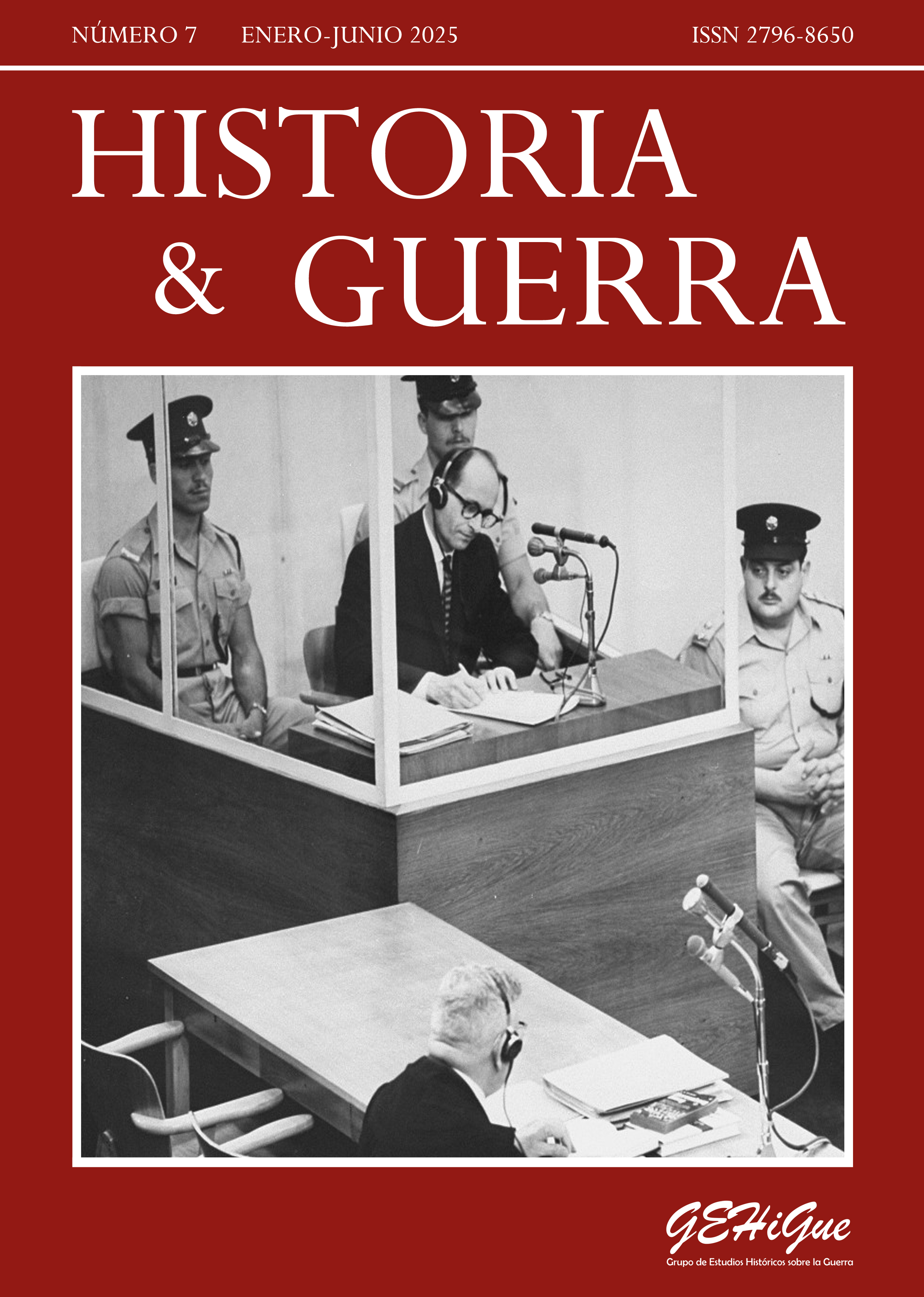Abd-el-Krim and the Rif Resistence Against the Spanish Army (1921-1927)
Abstract
The Rif War constitutes one of the early modern examples of irregular warfare, serving as a model for subsequent insurgencies against colonial powers. During this conflict, the Spanish army first, and later the French army, faced a formidable enemy, well-versed in the terrain, sober, astute, and of indomitable valor, traits frequently attributed to him. Confronted with a highly mobile adversary and with the terrain as their primary ally, the Spanish Army experienced confusion and suffered significant defeats, such as the disaster at Annual. However, upon regaining the will to prevail and reapplying classic principles of warfare, they managed to overcome the forces of the Rif leader Abd-el-Krim and, in cooperation with the French, thwarted his aspiration to establish an independent Republic in the Rif.Downloads
References
Balfour, S. (2002). Abrazo mortal. De la guerra colonial a la Guerra Civil en España y Marruecos (1909-1936). Península.
Barrios, L. (1893). Importancia de las campañas irregulares y en especial de la guerra de Cuba. El Correo Militar.
Bayo, A. (2008). One Hundred and Fifty Questions to a Guerrilla. Sardis.
Berenguer, D. (1918). La guerra de Marruecos. Ensayo de una adaptación táctica. Excelsior.
Berenguer, D. (1923). Campañas del Rif y Yebala, 1921-1922. Notas y documentos de mi diario de operaciones. Sucesores de Regino Velasco.
Caballero, F. (1983). Marruecos. La campaña del 21. Cifras reales. Revista de Historia Militar, (522), 81-94.
Cabanellas, V. (1896). La táctica en Cuba y en todo país cubierto y accidentado. Imprenta y Litografía del Depósito de la Guerra.
Calero, J. (1897). Guerras irregulares y de montaña. Menor Hermanos.
Callwell, C. E. (1906). Small Wars. Their Principles and Practice. General Staff-War Office.
Capaz, O. (1931). Modalidades de la guerra de montaña en Marruecos. Asuntos indígenas. Alta Comisaría de la República española en Marruecos.
Chacón, J. I. (1883). Guerra irregular. Imprenta y Litografía del Depósito de la Guerra.
Danigo, F. (2010). France and the Rif War: Lessons from a Forgotten Counter Insurgency War. (Northern Morocco. April 1925 - May 1927 [Master of Military Studies]. United States Marine Corps Command and Staff College.
Díaz de Villegas, J. (1930). Lecciones de la experiencia: enseñanzas de las campañas de Marruecos. Sebastián Rodríguez.
Díez Rioja, R. (2022). El desembarco de Alhucemas. La intrahistoria de una operación concluyente (1911-1925). Ministerio de Defensa.
Dirección General de Preparación de Campaña (1929). Doctrina para el empleo táctico de las armas y los servicios (2ª edición). Depósito de la Guerra.
Dosal, P. J. (2010). Comandante Che: Guerrilla Soldier, Commander, and Strategist, 1956-1967. Penn State University Press.
El Mesaoudi-Ahmed Messaud, F. (2015). El Rif en el primer tercio del siglo XX, (1900-1930) [Tesis doctoral]. Universidad de Granada.
Er, M. (2015). Abd-el-Krim al-Khattabi: The Unknown Mentor of Che Guevara. Terrorism and Political Violence, 29(1), 137-159.
Fernández Mateos, F. (1986). Carros de combate y vehículos acorazados en la guerra de España. Servicio de Publicaciones del EME.
Fleming, S. E. (1991). Primo de Rivera and Abd-el-Krim: The Struggle in Spanish Morocco, 1923-1927. Garland Publishing.
Fontela, S. (2021). Los procedimientos tácticos de las fuerzas enfrentadas en la guerra del Rif 1919-1922. Revista de Historia Militar, 65(1), 213-246.
Franco, F. (1926). Reformas necesarias. África. Revista de Tropas Coloniales, (25), 241-243.
Franco, F. (1976). Diario de una bandera. Doncel.
Furneaux, R. (1967). Abd-el-Krim, Emir of the Rif. Secher and Warburg.
García Figueras, T. (1926). El ataque de Abd-el-Krim a la zona francesa. África. Revista de Tropas Coloniales, (14), 34-38.
Goded, M. (2021). Marruecos. Las etapas de la pacificación. Salamina.
Guarner, V. (1924). Carros de combate. Historia, táctica, organización. Memorial de Infantería, (145), 78-117.
Guerrero, A. (2017). El desarrollo del carro de combate en el ejército español hasta la Guerra Civil (motorización y mecanización del ejército) en M. Gajate Bajo y L. González Piote (eds.), Guerra y tecnología: Interacción desde la Antigüedad al presente (pp. 453-478). Fundación Ramón Areces.
Guerrero, A. (2018). Los procedimientos tácticos en las campañas de Marruecos. Guerra Colonial, (3), 41-61.
Guerrero, A. (2022). La guerra irregular en el pensamiento militar español decimonónico (1863-1898). Revista Universitaria de Historia Militar, 11(23), 16-39.
Guerrero, A. (2023). Ejército español versus rifeños: organización y procedimientos tácticos de ambos contendientes en L. Álvarez Rey, Á. Gómez Porrúa y J. L. Ruiz Sánchez (coords.), Guerra del Rif. Cien años después (pp. 119-144). Universidad de Sevilla.
Guerrero, A. (2024). Guerra acorazada en España: el empleo del carro de combate durante la Guerra Civil (1936-1939) en J. M. Azcona, M. Íñiguez y J. Rodríguez (eds.), Ámbitos y designios de la Guerra Civil española (1936-1939). Sílex.
Hart, D. M. (1976). The Aith Waryaghar of the Moroccan Rif: An Ethnography and History. University of Arizona Press.
Herrero Pérez, J. V. (2017). The Spanish Military and Warfare from 1899 to the Civil War. Palgrave Macmillan.
Herrero Pérez, J. V. y Puell de la Villa, F. (2021). El Protector: el Ejército español de principios del siglo XX en D. Macías Fernández (ed.), A cien años de Annual. La guerra de Marruecos (pp. 29-76). Desperta Ferro Ediciones.
Jensen, G. (2014). Cultura militar española: modernistas, tradicionalistas y liberales. Biblioteca Nueva.
Madariaga, R. de (2009). Abd-el-Krim el Jatabi. La lucha por la independencia. Alianza.
Madariaga, R. de (2021a). En el barranco del lobo. Las guerras de Marruecos. Alianza.
Madariaga, R. de (2021b). “Rebeldes”, contrabandistas y aventureros: las harcas rifeñas y sus aliados en D. Macías Fernández (ed.), A cien años de Annual. La guerra de Marruecos (pp. 77-118). Desperta Ferro Ediciones.
Mathieu, R. J. (1927). Mémoires d’Abd-el-Krim. Librairie des Champs-Elysées.
Mola, E. (1922). Para los oficiales de infantería en Marruecos. Logroño.
Office of Strategic Services (1944). Native nationalism in Spanish Morocco.
Pennell, C. R. (1986). A country with a government and a flag: the Rif War in Morocco, 1921-1926. Middle East & North African Studies Press.
Sueiro, S. (1992). España en el Mediterráneo. Primo de Rivera y la cuestión marroquí, 1923-1930. UNED.
Trinquier, R. (1981). La guerra moderna. Cuatro Espadas.
Valero, V. (2011). The Campaigns for the Pacification of the Spanish Protectorate in Morocco: A Forgotten Example of Successful Counterinsurgency. School of Advanced Military Studies.
Willoughby, C. A. (1925). Campañas españolas en Marruecos. La Guerra y su Preparación, (5), 511-528.
Woolman, D. (1968). Rebels in the Rif: Abd-el-Krim and the Rif Rebellion. Stanford University Press.
Copyright (c) 2025 Alberto Guerrero

This work is licensed under a Creative Commons Attribution-NonCommercial 4.0 International License.

Historia & Guerra uses an international license Attribution-NonCommercial 4.0 International (CC BY-NC 4.0).
You are free to:
- Share — copy and redistribute the material in any medium or format.
- Adapt — remix, transform, and build upon the material.
- The licensor cannot revoke these freedoms as long as you follow the license terms..
Under the following terms:
Attribution — You must give appropriate credit, provide a link to the license, and indicate if changes were made. You may do so in any reasonable manner, but not in any way that suggests the licensor endorses you or your use.
NonCommercial — You may not use the material for commercial purposes.
No additional restrictions — You may not apply legal terms or technological measures that legally restrict others from doing anything the license permits.
Notices:
You do not have to comply with the license for elements of the material in the public domain or where your use is permitted by an applicable exception or limitation.
No warranties are given. The license may not give you all of the permissions necessary for your intended use. For example, other rights such as publicity, privacy, or moral rights may limit how you use the material.
The author retains all rights to his work without restriction and grants Historia & Guerra the right to be the first publication of the work. Likewise, the author may establish additional agreements for the non-exclusive distribution of the version of the work published in the Journal (for example, placing it in an institutional repository or publishing it in a book), with the acknowledgment of having been first published in this journal. Use of the work for commercial purposes is not permitted.














.jpg)















